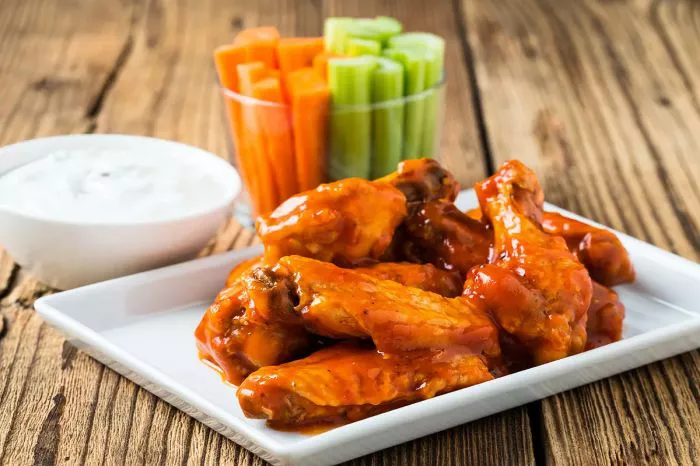Fried chicken wings from fast food restaurants are undoubtedly delicious, but when it comes to health, they can present a bit of a conundrum. Let’s dissect this topic from various angles to understand the nutritional implications and health considerations associated with indulging in this popular fast food item.
Nutritional Composition of Fried Chicken Wings:
Fried chicken wings typically consist of chicken wings coated in a seasoned batter and deep-fried until crispy. The nutritional profile of fried chicken wings can vary depending on factors such as the size of the wings, the type of batter used, and the oil in which they are fried. However, here’s a general breakdown of the nutritional composition of a serving of fried chicken wings (approximately 3-4 wings):
Calories: A serving of fried chicken wings can contain anywhere from 200 to 400 calories, with most of these calories coming from fat and protein.
Fat: Fried chicken wings are high in fat, with a significant portion of it being saturated fat. Saturated fats, when consumed in excess, can contribute to elevated levels of LDL cholesterol and increase the risk of heart disease.
Protein: Chicken is a good source of protein, and fried chicken wings provide a moderate amount of protein per serving. However, the protein content may be overshadowed by the high fat and calorie content.
Carbohydrates: While chicken itself is low in carbohydrates, the batter used to coat the wings often contains flour or other starchy ingredients, contributing to the carbohydrate content of fried chicken wings.
Sodium: Fast food fried chicken wings tend to be high in sodium due to the seasoning and breading process. Excessive sodium intake can lead to high blood pressure and other health issues.
Health Considerations:
Now that we’ve examined the nutritional composition of fried chicken wings, let’s delve into the health considerations associated with consuming them regularly:
High in Calories, Fat, and Sodium: Fried chicken wings are calorie-dense and high in unhealthy fats and sodium. Regular consumption of these wings can contribute to weight gain, cardiovascular problems, and hypertension.
Trans Fats: Some fast food establishments may use oils containing trans fats for frying, which are particularly harmful to health. Trans fats not only raise LDL cholesterol levels but also lower HDL cholesterol levels, increasing the risk of heart disease.
Low in Nutrients: While chicken itself is a good source of protein and certain nutrients like niacin and selenium, the frying process strips away some of these nutrients, leaving behind a less nutritious product.
Impact on Blood Sugar: The batter used to coat fried chicken wings may contain carbohydrates that can spike blood sugar levels, especially in individuals with diabetes or insulin resistance.
Portion Size: Fast food portions are often larger than recommended serving sizes, leading to overconsumption of calories, fat, and sodium in a single sitting.
Moderation and Healthier Alternatives:
While fried chicken wings may not be the healthiest option on the menu, they can still be enjoyed occasionally as part of a balanced diet. Here are some tips for making healthier choices when it comes to indulging in this comfort food:
Portion Control: Opt for smaller portion sizes or share a serving of fried chicken wings with a friend to avoid overeating.
Choose Grilled or Baked: Many fast food restaurants offer grilled or baked chicken options as alternatives to fried chicken. These preparations are lower in fat and calories while still providing protein.
Skip the Sauce: The sauces served with fried chicken wings can be high in sugar and calories. Consider skipping the sauce or opting for a lighter sauce option.
Balance Your Meal: If you’re craving fried chicken wings, balance your meal by including plenty of vegetables or a salad on the side to increase the nutritional value and fiber content.
Homemade Versions: Consider making your own healthier version of fried chicken wings at home using leaner cuts of chicken, whole wheat flour or breadcrumbs, and healthier cooking oils like olive oil.
Conclusion:
In conclusion, while fried chicken wings from fast food restaurants may be delicious, they are not the healthiest choice due to their high calorie, fat, and sodium content. However, enjoying them occasionally as part of a balanced diet is unlikely to cause significant harm. It’s essential to practice moderation, make healthier choices when possible, and balance indulgences with nutritious options to support overall health and well-being.

